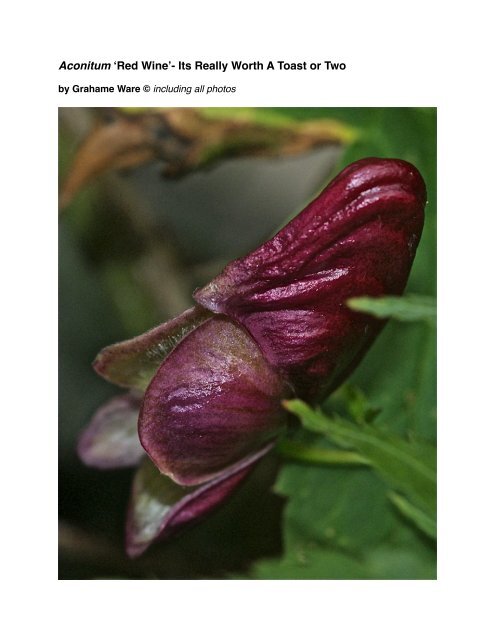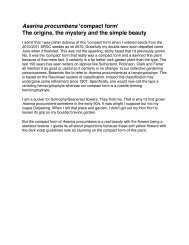Aconitum 'Red Wine' - Owl and Stump Rare Plants
Aconitum 'Red Wine' - Owl and Stump Rare Plants
Aconitum 'Red Wine' - Owl and Stump Rare Plants
Create successful ePaper yourself
Turn your PDF publications into a flip-book with our unique Google optimized e-Paper software.
<strong>Aconitum</strong> ʻRed Wineʼ- Its Really Worth A Toast or Two<br />
by Grahame Ware © including all photos
It finally happened for me after years of waiting for it. My seed-raised plants (well, okay-<br />
a seed raised plant) of <strong>Aconitum</strong> <strong>'Red</strong> <strong>Wine'</strong> blossomed gloriously in my new garden<br />
here in Yellow Point, north of Ladysmith on the east coast of Vancouver Isl<strong>and</strong>. I'd finally<br />
found the right spot <strong>and</strong> done the right things to make it happy. Far from being just an<br />
ordinary table wine, this one has good vintage, bouquet <strong>and</strong> spirit. Allow me to sketch<br />
the history of this plant as well as my own personal thread in that cord. There has been<br />
very few entries in horticultural literature on this natural hybrid. This one is likely the<br />
most extensive.<br />
History<br />
<strong>Aconitum</strong> <strong>'Red</strong> <strong>Wine'</strong> is a member of the climbing clan of Monkshood. However, unlike<br />
most of its kin, it is not wispy, small-flowered or anemic. This is a classy fellow that<br />
shows the usual toughness of <strong>Aconitum</strong> but has an extra delicacy in its form <strong>and</strong> colour.<br />
Jonas Bengsston of Djupedals <strong>Plants</strong>kola in Sweden told me the following. "In the<br />
Spring of 1989, Gothenberg Botanical Garden received seeds of what was supposedly<br />
<strong>Aconitum</strong> hemsleyanum from the Shanghai Botanical Garden. At Gothenberg thay<br />
already had clones of A. hemsleyanum <strong>and</strong> they discovered that it did not match. The<br />
flowers are as bug as those of the popular herbaceous <strong>Aconitum</strong> 'Spark's variety' <strong>and</strong><br />
the colour is a wine red (RHS colour chart 185A). It is likely a natural hybrid that comes<br />
true from seed."<br />
Bengsston was the first nurseyman in Sweden (<strong>and</strong> by extension the world) to trial it<br />
<strong>and</strong> then build up stocks. I had contacted Bengsston in 2005 as part of a large feature<br />
story I was developing for the RHS <strong>Plants</strong>man Journal on the "Climbing Clan of<br />
<strong>Aconitum</strong>". See the full Spring 2006 article here on my website:<br />
http://www.owl<strong>and</strong>stumprareplants.com/sites/default/files/pdf/<strong>Plants</strong>man2006.pdf<br />
In 2006, Bengsston generously sent me a whack of seed so that I was able to share it<br />
with people like Ellen Hornig, that ran that wonderful nursery in upper NY state, Seneca<br />
Perennials (alas, sadly, it is no longer going). Ellen, in turn, has shared seed <strong>and</strong> plants.<br />
Garden Culture<br />
I was able to start a number of seedlings down the path to maturity in 2006 <strong>and</strong> 2007.<br />
However, the climate of the N. Okanagan (especially the Winters) were too much. Oh,<br />
they didn't perish (mostly), they just sulked <strong>and</strong> the following Spring, rallied a bit before<br />
they swooned in the heat of Summer's string of 40F. temps! Who could blame them?<br />
Still, most lived even after moving house in summer (late June of 2008) with no beds or<br />
gardens to put them in. The following Spring I decided (after establishing a few 'beds' in<br />
the s<strong>and</strong>stone), that I would spot a few around. Too much sun or not enough? Enrich<br />
the soil or leave it lean <strong>and</strong> rocky? Bengsston indicated that in the cool, west coast<br />
maritime climate of Sweden that they did best in full or near full sun. Yet, the German<br />
<strong>and</strong> French growers thought that semi-shade was optimum. Likely this is due to the<br />
stronger sun of the Continent.<br />
It can get very hot here in the summer being on the leeward side of the Arrowsmith<br />
massif. The first spot that I trialed was under a Pinus parviflora var brevifolia. It was
doing fine through the early <strong>and</strong> late Spring but then it fried in the record Summer heat<br />
of 09 <strong>and</strong> I lost that one. The only compensation that year was that me <strong>and</strong> my Beloved<br />
got to swim a lot in our local ocean beaches. Another strategically placed plant made a<br />
shrivelling goodbye in another bed under a small Magnolia. Not so strategic afterall.<br />
The remaining pots of <strong>'Red</strong> <strong>Wine'</strong> trembled as I approached them the following Spring<br />
with border spade <strong>and</strong> cultivator in tow. I had decided that the next thing I had to do was<br />
to mimic their natural situation. 'What is that?' you may well ask. In the wild they are<br />
generally found in swales or near creeks in forests where their roots are in thick layers<br />
of well composted duff that overlays a gravelley, mineral-rich substrate. Foster shrubs<br />
aid in the climbing <strong>and</strong> clambering whilst at the same time provide some amelioration<br />
from the sunlight. I decided that the north side of my house underneath a small Acer<br />
hybrid would be the next best trial spot. There was plenty of morning sun especially<br />
when the sun wheels around in Summer <strong>and</strong> splashes <strong>and</strong> dashes off the siding full<br />
force through 11 AM. After planting it in with just its little terminal bud barely above the<br />
soil level, I side-dressed it liberally with a mix of well-composted fir bark mulch <strong>and</strong> old<br />
cow manure <strong>and</strong> gave it a good soaking of my chicken manure/kelp tea based from my<br />
rainwater barrel. I did this at plant out at twilight (might have even been on the new<br />
moon!- I wasn't taking any chances) <strong>and</strong> used the tea concoction twice a week. The<br />
plant grew nicely that year but did not even get close to flowering.<br />
But it was okay, it was alive. The following year in August of 2011 of a very backward<br />
Summer <strong>and</strong> a cold, wet Spring, it flourished <strong>and</strong> budded up. Then it flowered<br />
magnificently. Five years had passed since it had been ushered into existence. I had<br />
helped it with a little twist tie or two getting up the tree which itself is only 5'-6' tall x 4'<br />
wide. After that I let it do its own thing with the only asterisk being that my cat had<br />
swatted at one of the green buds <strong>and</strong> dislodged a branch somewhat. So I curled it<br />
gently 'round a small branch <strong>and</strong> out of further temptation.<br />
By the end of August when a dawdling Summer finally kicked in (<strong>and</strong> the crickets started<br />
to play their cellos), the flowering was in overdrive. They were dangling <strong>and</strong> dancing in<br />
the breezes on strong stems with the Acer x m<strong>and</strong>shurica providing the perfect foil <strong>and</strong><br />
dancing partner. They were very classy. They kept going through most of September.<br />
The flowers are about 2 1/2" long. Two other plants grew somewhat but did not even<br />
come close to making a show. It's the last Sunday of January as I write this passage<br />
<strong>and</strong> a little probing around the roots tells me that "Duke" is ready for a return<br />
engagement. Two others in the ground are looking like they'll make a run as well.<br />
I sure you can see why the Eurpean equivalent of the Perennial Plant Association, the<br />
ISU (International Hardy Plant Union), judged Red Wine "an outst<strong>and</strong>ing plant" in 2000<br />
after trials in many gardens by many members of that association. Its a fabulous plant<br />
compared to the likes of the species A. vilmorianum, A. hemsleyanum, A. episcopale,<br />
etc. What's the expression?-"It blows their doors off!"<br />
Conclusion<br />
I wrote in 2006 that Red Wine was not widely available. However, now Jelitto Seed is<br />
offering it for sale <strong>and</strong> it is very expensive. 1 gram will cost you 24 Euros <strong>and</strong> this will
produce about 200 plants if all goes according to Hoyle. A packet costs 8 Euros <strong>and</strong> will<br />
likely produce 15-20 plants. Contact info for both N America <strong>and</strong> the UK here: https://<br />
www.jelitto.com/haupt_en.html<br />
In Canada, Kristl Walek's Gardens North Seed is selling 30 seeds for $5.25 which<br />
seems like a good deal. http://www.gardensnorth.com/catalogue/database.cgi?<br />
Mode=List&Field=Category&Search=CLIMBERS<br />
Despite my travails, you may find that even under ideal conditions, it will likely take you<br />
3-4 years from seed to flower.<br />
I thought that I was going to have a veritable bounty of seed but one day (night?) deer<br />
paid a visit <strong>and</strong> duly consumed most of the seed. Somewhere in the woods nearby,<br />
some Red Wine is germinating this Spring having gone through a rather curious<br />
scarification process. Since moving here I have developed a keen taste for venison.<br />
I will have some plants on offer at the Spring Sales for the AGCBC <strong>and</strong> VIRAGS so<br />
keep your eyes open at the <strong>Owl</strong> & <strong>Stump</strong> table. These plants are several years old <strong>and</strong><br />
should be ready to flower quite soon.<br />
What follows is a photo essay showing Red Wine through its various stages.<br />
Let's all raise a glass to a great new plant <strong>and</strong> say thankfully to Red Wine with a glass of<br />
red wine in our h<strong>and</strong>s- "CHEERS!"
August 2011: buds emerge like chunky Jolly Green Giant peas<br />
They swell lengthwise to get their unique shape <strong>and</strong> begin to colour up on their tips<br />
Looking very determined as it colours up from green to burgundy to wine red
The first flower before opening looks almost garnet coloured in dim light<br />
A closer view of the same above. Note the light from my flash bouncing off the top.
Mid August <strong>and</strong> finally the first flower. Note how the colour gets lighter like wine!<br />
Soon they were in overdrive <strong>and</strong> each flower stayed around for weeks.
Clusters of Red Wine pumping out on strong pedicels
Mr & Mrs <strong>'Red</strong> <strong>Wine'</strong>...that's Mrs. on the left!
"Say ahhh!" (note the pollen from my little paintbrush <strong>and</strong> the bumblebees)
The late stages of flowering with top helmet staring to separate from the bottom



